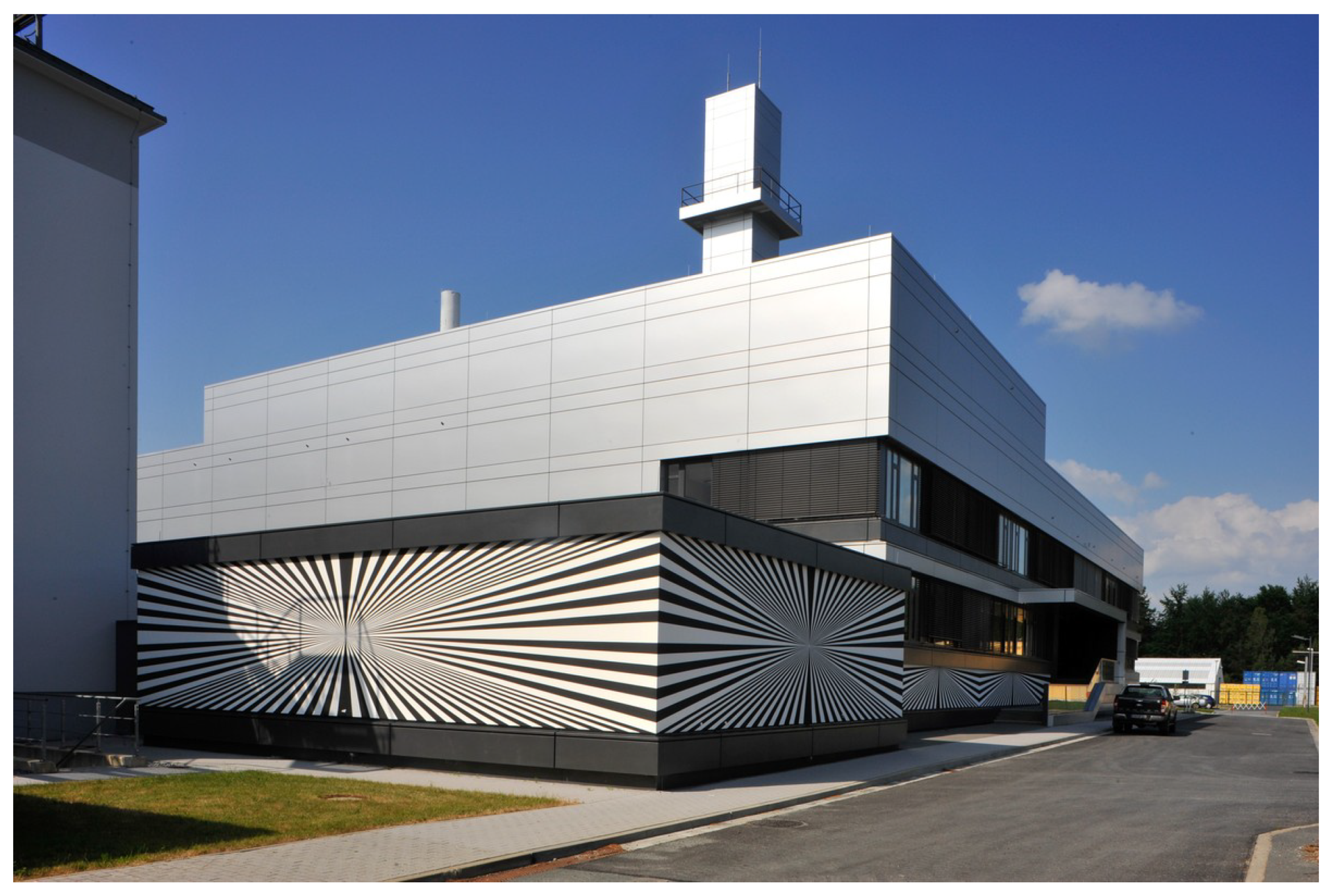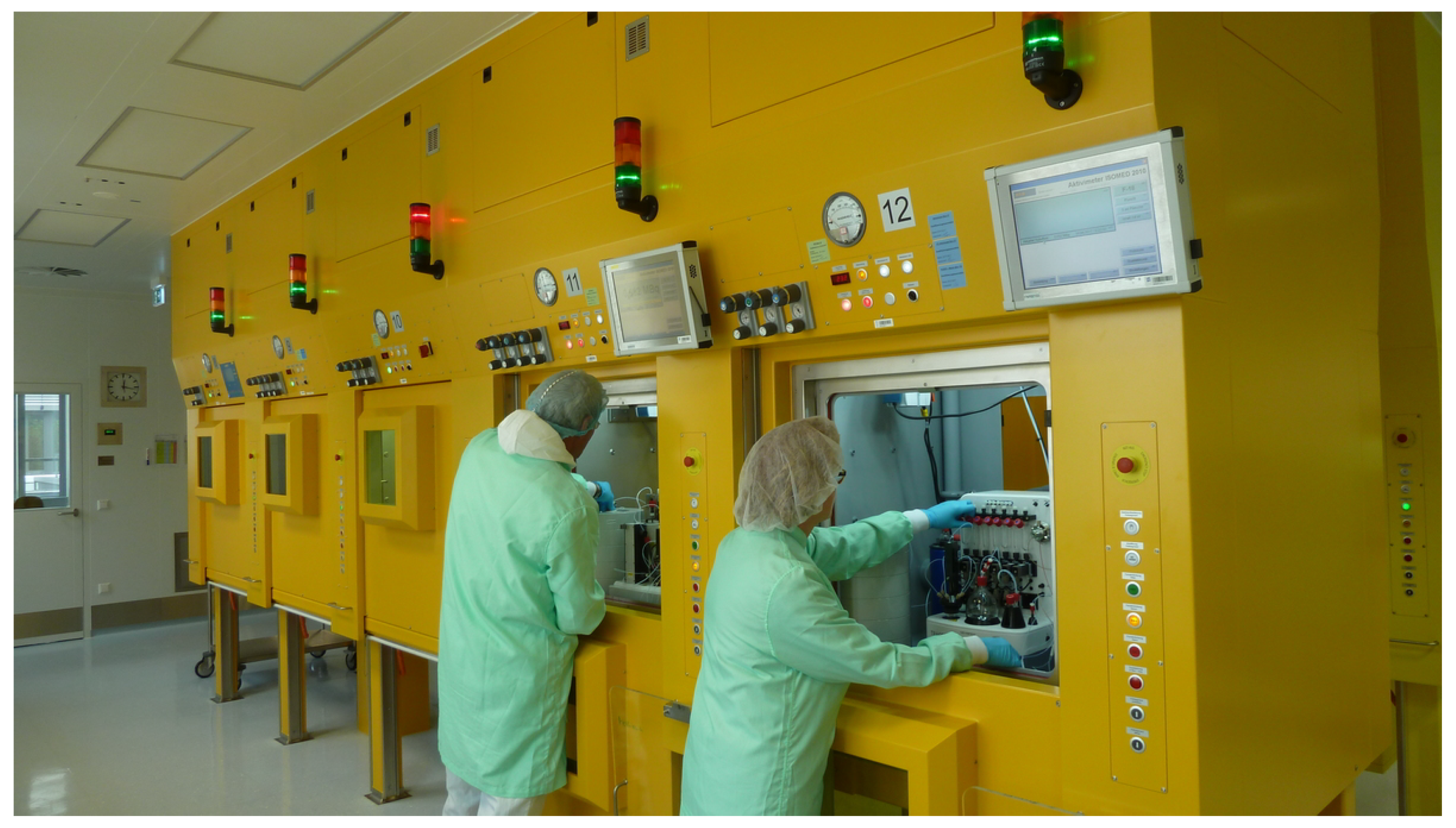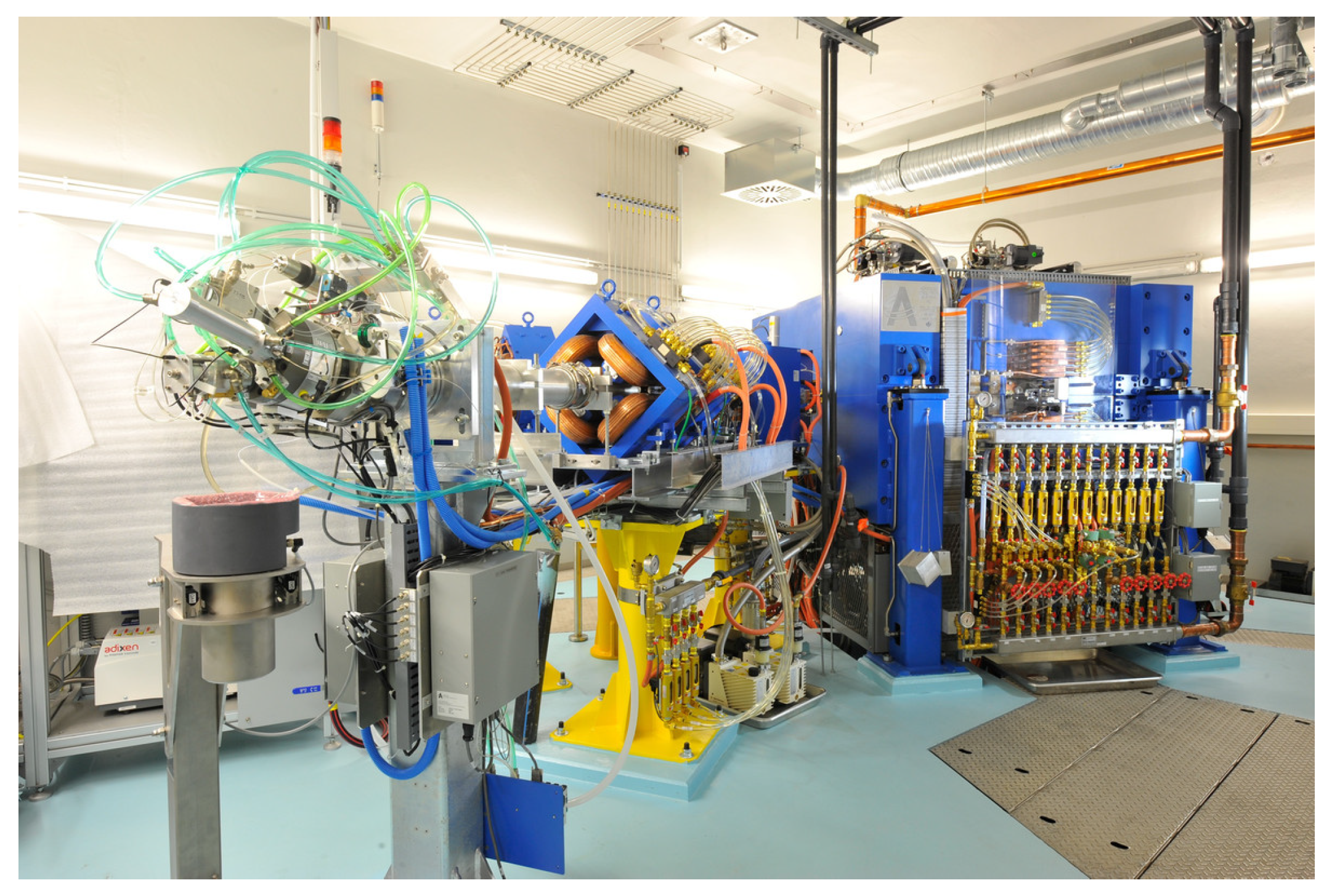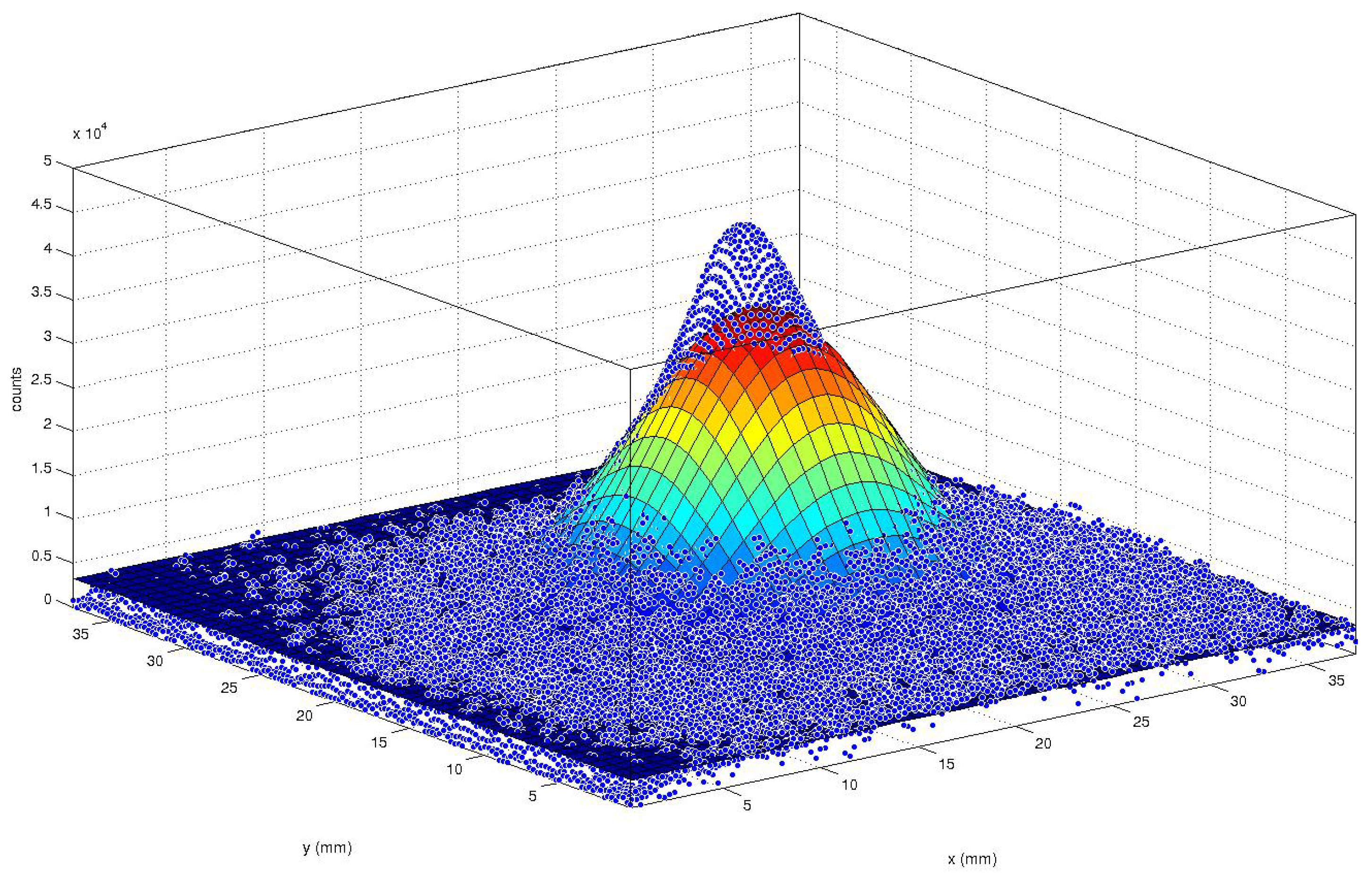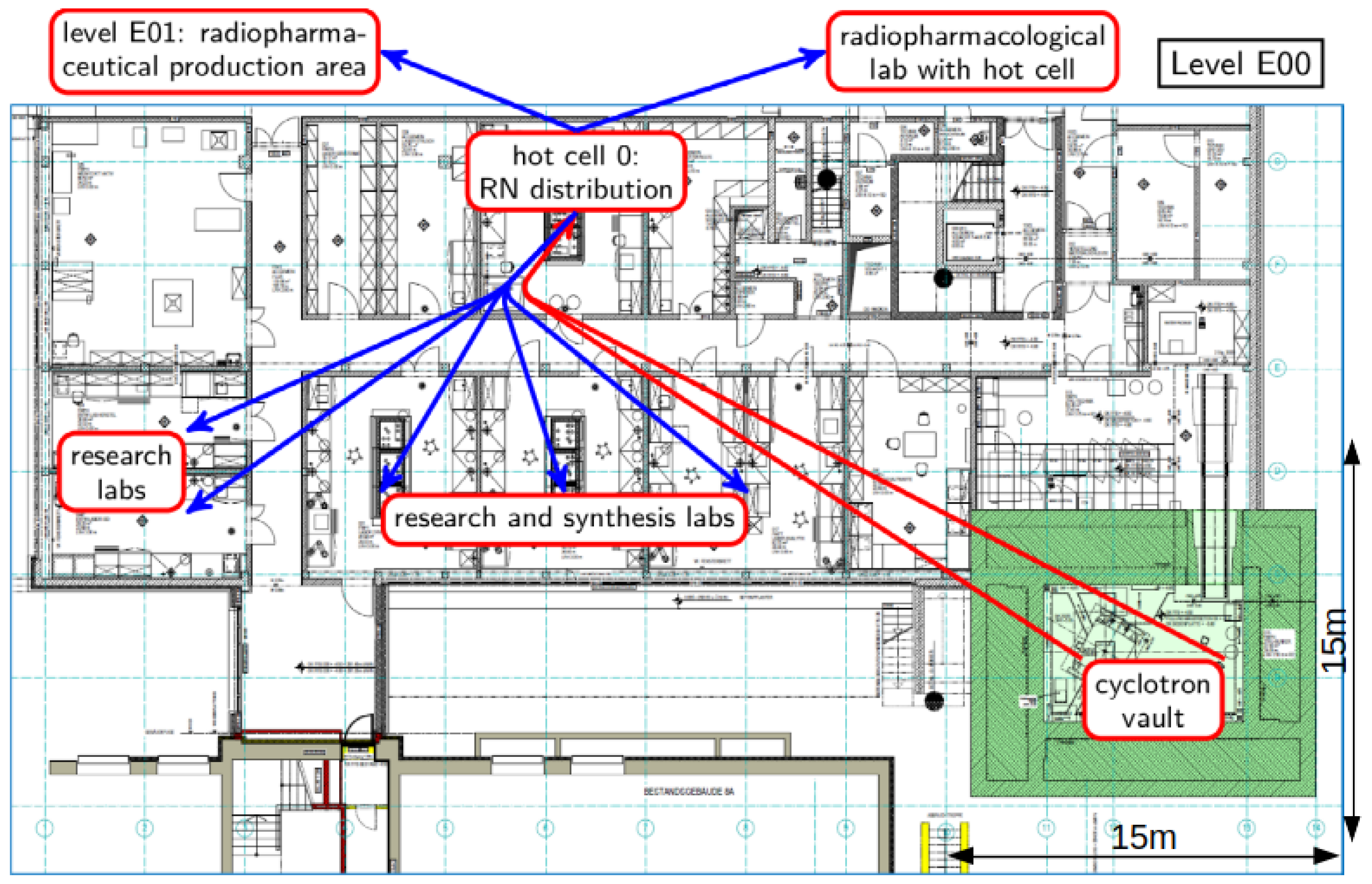1. Introduction
Radiopharmaceutical research and the production of radiopharmaceuticals have a long history at the Research Center in Rossendorf. The production of radiopharmaceuticals started in 1958 with a nuclear research reactor (10 MW) and the Cyclotron U-120 (Leningrad). A broad scale of radiolabeled products based on 14C, 131I, 123I, 32P, 75Se, 67Ga, 85Sr, 111In, 211At and fission radionuclides such as 90Sr/90Y, 99Mo were provided. Furthermore, the Research Center was the second producer of fission 99Mo/99mTc-generators.
The year 1997 marked the official opening of Rossendorf PET-Center for research and application including the manufacturing authorization for PET drugs. The marketing authorization includes [
18F]FDG (GlucoRos), [
18F]Fluoride (NaFRos) and [
18F]FDOPA (DOPARos). Furthermore, there are 15 different radiopharmaceuticals available on demand. In the past, radionuclide production, pharmacological research and the pharmaceutical production were located at different places at Helmholtz-Zentrum Dresden-Rossendorf (HZDR) [
1].
The new Center for Radiopharmaceutical Cancer Research (ZRT), as it is shown in
Figure 1, was established to centralize the main units: a high current proton cyclotron, a radiopharmaceutical production—GMP (Good manufacturing practice) unit including the quality control, laboratories for PET-radiochemistry, chemical laboratories, laboratories for biochemical investigations inside and outside the controlled area, laboratories for small animal imaging (small animal PET/CT, PET/MR, SPECT, OI, MR) and a laboratory animal facility (mice and rats).
The ZRT completes the research infrastructure of the Institute of Radiopharmaceutical Cancer Research. In close cooperation, the six departments at the institute are developing and testing radioactive drugs for cancer diagnostics and therapy. The corresponding processes are accompanied from the idea (clinical need) to the introduction of novel drugs into clinical practice. The radiopharmaceuticals are produced for research and for hospital use.
2. The Production of Radiopharmaceuticals
Due to the short half-lives of 18F and 11C, the radionuclides and the corresponding PET radiopharmaceuticals are produced in one site, which means the cyclotron, GMP production area and quality control are located in one building. If the medical application is not situated in the campus area, the transport time should not exceed one half-life of the radionuclide. As a rule of thumb, the time lag between radionuclide production and patient investigation should not exceed three half-life periods, consequently the production of PET radiopharmaceuticals is faced with a number of challenges.
As is well known, a number of prerequisites or work steps must be fulfilled for the production of a radiopharmaceutical: The radiolabelling reaction, i.e., the “introduction” of the PET radionuclide into the biomolecule, is performed by synthesis modules in lead-shielded hot cells to minimize the radiation exposure to the staff. All production steps have to be performed under clean room conditions and according to GMP guidelines. For that purpose a clean room area of about 200 m
2 was established within the ZRT. It is equipped with 14 hot cells under clean room conditions B and C (see
Figure 2).
The majority of the routinely produced radiopharmaceuticals ([18F]FDG ([18F]fluoro-2-desoxy-D-glucose), [18F]FDOPA (3,4-dihydroxy-6-[18F]-fluoro-L-phenylalanine), Sodium [18F]fluoride, [11C]Methionin, [18F]FMISO ([18F]Fluoromisonidazole)) are applied for cancer diagnostics. [18F]FDOPA and [18F]Flutemetamol (Vizamyl©) are produced for diagnostics of neurodegenerative disorders.
The ZRT has also created optimal conditions for the quality control of radiopharmaceuticals. The low level of non-radiolabeled compound present in the radiopharmaceutical precludes the application of common analytical techniques like NMR (Nuclear magnetic resonance) and mass spectroscopy. Identity, purity and radiochemical purity of the pharmaceuticals have to be assessed with (radio)-HPLC (High-performance liquid chromatography) and thin layer chromatography. Potential contamination is determined by gas chromatography. Further physicochemical tests include the purity of the radionuclide, pH-value and osmolarity. Additionally, the sterility and absence of pyrogens of the radiopharmaceutical is assessed. It is noteworthy that this entire quality control process has to be performed for every new batch and should be completed within the shortest time possible, ordinarily within 30 min, to ensure adequate time for patient application.
3. The TR-Flex Cyclotron
The former cyclotron of the HZDR, an IBA Cyclone 18/9, was put into operation in autumn 1996. After 18 years of routine operation, comprehensive upgrades would have to be necessary to fulfill the new demands in the second decade of the 21st century. On the other hand HZDR could not forego the production of radionuclides with the Cyclone 18/9 during the ZRT building phase. Thus, HZDR decided to install a new cyclotron with higher ion energy and higher ion bean current in ZRT building and not to move the Cyclone 18/9.
The new TR-Flex cyclotron, shown in
Figure 3, from Advanced Cyclotron Systems Inc. (ACSI, Richmond, BC, Canada) [
2] was put into operation in 2017. The cyclotron is equipped with two extraction ports. Both extraction foils are radially movable to adjust the energy of the extracted proton beam in the range of 18 MeV up to 30 MeV. Two beamlines are connected behind a combo magnet on the extraction port 1. Two 4 port target selectors are installed at one beamline and the second extraction port. The cyclotron and the targetry is characterized by the following key parameters:
Acceleration of H− and extraction of H+ ions
External multi-cusp ion source, ion current up to 300 μA
Adjustable energy in the range of 18 MeV (14 MeV) up to 30 MeV
dual beam operation with split ratio 1:100 to 50:50
Two [18F]F− water targets and one [18F]F2 gas target
One [11C]CH4 gas target and one [11C]CO2 gas target
One 30° and one 90° solid state target
The TR-Flex is in stable and reliable operation now. Although, the cyclotron is designed to extract ions in the range of 18 MeV up to 30 MeV it is of real interest to extract ions at lower ion energies. The reaction cross section for a lot of radionuclides are higher and the impurities are lower for lower ion energies. For example
64Ni(p,n)
64Cu production should be done below 15 MeV. Hence, experiments were done to determine the lowest possible ion extraction energy. It was possible to extract ions at energies as low as 14 MeV at the beamline extraction port. Autoradiography measurements at ion beam energies of 14 MeV and 30 MeV were executed to determine the profile of the proton beam hitting the solid target. The Autoradiographic measurement of a 30 μA beam current with an energy of 30 MeV is shown in
Figure 4.
A two dimensional gaussian function was fitted to the measured profile to determine the beam size in x- and y- direction.
We measured a pretty well shaped beam profile for lower and higher energies at the target selector at the end of the beamline as it is written in
Table 1. The maxium beam current is limited to 50 μA for low energies, because of a higher beam loss in the beamline below an energy of 18 MeV.
The first production runs for
64Cu using 14 MeV protons for the
64Ni(p,n)
64Cu reaction [
3,
4] were carried out and evaluated. Typical irradiation parameters for the copper production are an ion current of 50 μA and an irradiation time of 90 min. The molar activity of the
64Cu is about 1 TBq/μmol. We achieved an activity of 15 GBq that is corresponding to a saturation yield of 3.8 GBq/μA.
The following radionuclides have been produced reliably with the TR-Flex since the beginning of 2018. Typical production parameters of the new TR-Flex and the achieved activities are presented in
Table 2.
4. The Radionuclide Distribution System
A new Radionuclide Distribution System was developed and installed by the Department of Research Technology at HZDR. The liquid and gas targets are unloaded through capillaries to a central hot cell. Henceforward the radionuclides can be distributed automatically to the GMP unit and the research hot cells.
The system controls the target unload and the transport to the hot cells within the whole building. The gas is transported by stainless steel capillaries with an inner diameter of 1.4 mm and the liquid is transported by PTFE capillaries with an inner diameter of 0.8 mm. The transport distances can reach up to 100 m. The supervision of the relevant parameters and interlock system for the radiation protection (shielding of the hot cells, correct transportation path, correct ventilation system) and generation of the target unload clearance signal sent to the cyclotron is done automatically by the Radionuclide Distribution System.
The cyclotron targets are unloaded to the central hot cell “0”. Several multi position valves in this hot cell allow the activity dosing and distribution to 25 hot cells in the whole Center for Radiopharmaceutical Cancer Research. Normally this is an automatic transport but also an manual operation and a so-called emergency mode, that allows to abrogate the interlock system, is possible. A schematic view of the distribution is shown in
Figure 5.
Solid targets are unloaded to a transport container on a hand cart. An unload clearance signal is generated when the hand cart is docked at the solid target system and the cooling water blow out as well as the unload process is done by the control system of the cyclotron.
5. Conclusions
In our contribution we presented the new Center for Radiopharmaceutical Cancer Research including the new production and research infrastructure. Furthermore, we introduced the new cyclotron TR-Flex including first results of the radionuclide production and beam characterization measurements. The Institute of Radiopharmaceutical Cancer Research is now concentrated within two interconnected buildings at HZDR. The new research and production units are fully operational. The new research complex remarkably expands the capabilities for high-end research. The parameters of the new cyclotron open new opportunities with regards to the yields of produced radionuclides and the usable nuclear reactions. This expands the range of producible radionuclides.
Some improvements to the solid target system will be done in the near future. The first point is to modify the solid target system to use targets thicker than 2 mm. Furthermore, an energy degrader will be designed and installed to reduce the energy at the beamline target to below 14 MeV. The production of further radionuclides will be started step by step.
In comparison to similar medical institutions, the TR-Flex cyclotron gives the opportunity to produce radionuclides also by the (p,2n) and (p,3n) reaction. The close cooperation with the National Center for Tumor Diseases Dresden and the National Center for Radiation Research in Oncology Dresden offers unique possibilities for research and application of radiopharmaceuticals.
